Research & Development: Creating the Slate Pro Audio RAVEN MTX
The RAVENS are landing.
When Slate Pro Audio’s RAVEN MTX multitouch production console started appearing at trade shows, the WOW factor was through the roof. People saw something they had never experienced before, or even dared to seriously consider.
On exhibit: A giant touch screen display featuring a powerful multitouch mixer (the RAVEN MIXER) that can control all major DAW’s, along with a flexible and user-customizable, multifunction toolbar. A full-featured analog monitoring section with multiple speaker outs and input sources, smart phone connectivity, USB, multiple headphone send and cue options, and a lot more were part of the package.
The result is a console vastly different from any other control surface out there. And now that they’re becoming available, early-adopting pros are installing RAVENS into their studios and going to work with them.
As captivating as the RAVEN is, its beauty is not just skin-deep. SonicScoop found out just how intensive its story — and philosophy — is when we talked to Slate Pro Audio’s VP of Creative Operations Alex Oana, the Co-Designer and Product Manager for RAVEN.
Working together with Steven Slate and the company’s dedicated team, Oana experienced first-hand the inspiration, intensive problem-solving, and hard work required for this hyper-ambitious fantasy to became an audio reality. Here’s the way it went down:
Starting from the 10,000-ft. view, how does Slate decide what new products – hardware and/or software – to develop?
Most of the time product development at Slate begins with Steven asking himself, “What do I need?”
In the case of the RAVEN he had been working on a monitor controller he wanted for his studio when we met. I suggested to Steven that a studio hardware product like that should be built around the DAW. Steven kept saying, “Let’s make it bigger, like a console” and I kept throwing in features like integrated USB, iPhone dock and laptop reference speakers which led to him hiring me!
We took our non-multitouch RAVEN X1, a huge confusing console that made no sense, to NAMM 2012.
Out of frustration I said to Steven, “We claim to be innovative, but this [Raven X1] isn’t innovative at all. What would be innovative is if we made the Raven a giant touch screen so you can touch your DAW directly.”
Three things separate Steven Slate from other developers:
1) He can’t let a good idea go,
2) He won’t rest until he sees an idea through, and
3) It has to be perfect.
My little multitouch idea that I had been dreaming of since I first started working with Pro Tools in the late 1990s started our journey along the “bleeding edge.” After 18 months of blood sweat and tears we know first-hand what that term truly means.
From there, what made the RAVEN a priority for Slate to develop?
DAWs are amazing. As advanced and miraculous DAWs are, there’s been no intuitive way to interact with them. Before RAVEN, working with a DAW was like trying to play a guitar with a trackball.
We looked around and it just seemed like everybody who should be making multitouch hardware and software was just sleeping. We really wanted the RAVEN for ourselves because using a keyboard and mouse to create music sucks and it’s not healthy. My elbow, wrist and hands were killing me!
When we debuted the prototype RAVEN at AES 2012 we knew one of two things would happen – we’d be the laughingstock or people would flip out. Luckily people flipped out.
Steven said that Slate wanted to “respect the console heritage” in creating the RAVEN. What does that mean from an ergonomic, creative and sonic standpoint?
Think of a wraparound Helios console from the 1970s. It was designed to place every control the engineer would need within easy reach. As studio tools expanded the consoles got bigger, racks of outboard sprung up behind and to the sides, making it impossible for the engineer to work in the sweet spot.
Now all those tools, minus the microphones and converters, exist inside your computer and DAW. The RAVEN makes accessing these infinite tools intuitive and direct, like it was when you could reach out and touch your console and your outboard gear.
At Slate we firmly believe in the virtues of virtual. Virtual replications of console, tape, and stereo bus compressors…. All sounding great, vastly more affordable, instantly recallable, and facilitating collaboration.
What was the initial vision for RAVEN – what did you see as the big creative/technical opportunities that would result from a multitouch production console for Pro Tools?
It seems so simple: to touch what you see. Doesn’t that just make sense? That’s where it started. Talented software engineers and graphic designers create gorgeous, infinitely adaptable, virtual landscapes within the pixels of the computer display. Steven and I just wanted a way to reach into that world.
The RAVEN is compatible with every major DAW and will initially ship with Pro Tools control – Logic and others soon to follow. No matter what DAW you use, you’ve been handicapped trying to access all its features by dragging a mouse pointer from one place on the screen to another.
Right out of the gate, RAVEN’s multitouch mixer and user-customizable controls are simultaneously familiar and innovative. Yet we are at the dawn of what is possible in multitouch interaction with software. I have so many ideas I want to do – ideas that will make working with audio, and other creative fields for that matter, more intuitive and fun.
Now think again about this gorgeous virtual world I talked about. Most of those graphic user interface (GUI) design methodologies are based on physical, analog hardware ergonomics. We will make the transition to a virtual mindset – create new ways of interacting with our software, sculpting sound with our hands… Sky’s the limit.
Conversely, what did you identify as the most significant challenges you would face in realizing that vision?
It’s crazy that Apple OSX, made by the same people who popularized handheld multitouch hardware, is not inherently multitouch.
We are using every trick in the book – and many new ones invented by our programing team – to create a seamless multitouch experience.
Please describe the major stages of the design process – what had to happen in order for the RAVEN to move from concept to prototype to finished product?
Idea
Balls
Research
Finding the right collaborators
Trial and error
Belief/Stress/Belief/Luck
Timing
Overwhelming public reaction
Money&Stress
A kick ass team
Creative solutions
Stress&Money
A market hungry for innovation
Tweaks
Stamina
Of all those stages, which proved the most complex to complete? Why?
Oddly enough, the digitally-controlled analog circuitry and the physical console itself were by far the most difficult. Building prototypes, making revisions, building more prototypes… hardware is hard. Software just seems easier and more fun to develop.
All aspects of the RAVEN were thoroughly researched. For instance, getting the right glide for the touch glass required a lot of trial and error.
Did you have any difficulties in making RAVEN interface cleanly with Pro Tools itself?
We didn’t know if any of it would work. There were dozens of conversations in which Steven and I would ask our lead programmer, “Can we ______?” His response was often, “I’m not sure. I think so. Let me find out.” Sometimes we’d hit a brick wall and figure out a work-around. Most of the time he did figure it out, sometimes easily and sometimes with a significant amount of voodoo.
We were pinching ourselves and making little cellphone videos the first time we had multitouch control running on Mac OS. It was, and still is, a world first. It was like magic. A moment of awe. We felt like pioneers.
Are all Pro Tools-compatible plugins ready to go on RAVEN? What makes a plugin optimized for this workflow?
You can touch any plugin with single touch via the RAVEN, but some plugins are easier to touch than others because of the way the GUI is designed.
Plugins are now being developed for multitouch with larger controls, knobs you can turn – the plugin itself will be able to detect whether it’s running on a RAVEN and automatically kick-in the multitouch functionality.
What were some surprises along the way that you learned about human interface design, specifically, as you built the RAVEN?
We thought the correct angle for the RAVEN was going to be low, like a console. That might make sense if we were doing just faders, but because the RAVEN is also the main computer display, we realized a more present 40° angle was essential for good posture and easy viewing and reach.
We built a funny wooden table to hold one of our early touch displays at various angles. We still have it out back somewhere – dusty and rained on. It can be tilted from flat to about 45°. All the guys at Slate sat at this mockup table and worked with various DAWs, changing the angle. The 40° angle was the winner.
Looking at the console, we were worried about the acoustics implications of this relatively steeply angled, large glass surface which encountered skepticism at the 2012 AES debut. Among the skeptics was renowned acoustician and studio designer Wes Lachot. But Wes didn’t just criticize, he did his homework. Back at his design studio, Wes input the RAVEN’s dimensions into his acoustic modeling software and delivered this surprising result:
“The good news about your [RAVEN] console design: The 40° angle precludes the comb filtering effect of a typical console. That’s something you can advertise – that’s a cool thing.” — Wes Lachot, November 2012
Is the RAVEN meant to replace the console, or simply complement it? What are the different scenarios that you can see it being implemented in studios, either personal or world-class commercial facilities?
There was a time when people couldn’t imagine making world-class records without consoles, tape machines, or outboard gear. Now listen to what we do, 100% inside the computer.
The RAVEN is simply a more direct path into your computer. And unlike a hardware console or controller, it’s near-infinitely adaptable. Remember the first few times you dialed phone numbers on your iPhone. It took a minute to get used to. Now it’s faster and just makes more sense than clunky physical buttons.
The RAVEN is designed to be at home in any studio scenario: tracking, overdubbing, editing, ADR, post production, mixing…
Who do you see as being early adopters of the RAVEN? And what type user do you think will need some convincing?
It’s not surprising that very successful musical artists, engineers, and audio producers are innovative in their techniques, their creative vision, and in their hunger for new tools to help them create and/or improve their workflow.
Some of our first RAVEN customers are these types of people – household name recording artists and top industry pros. It won’t be long before word gets out who has RAVENs.
I want to talk about that word “workflow” for a minute. It’s so unromantic. But it’s important because if you have good workflow you spend less time working and more time creating. That’s a major point of the RAVEN.
The RAVEN will appeal to anyone who finds a computer display and a mouse pointer a limited means for creating their art. Like any new technology, there are leaders and there are the people who have to wait and see. The RAVEN’s multitouch technology is inevitable – it’s no longer a matter of “if,” it’s “when.”
I take it you’re getting plenty of feedback from people at trade shows and private demos. How are you deciding what to incorporate ASAP, versus putting on the list to do later?
The funny thing is, just being able to touch your computer directly is revolutionary. Opening that door is worth the price of admission. The fact that we also created the world’s first multitouch mixer to run on Mac OSX and a flexible set of tools for interacting with your DAW is almost like icing on the cake.
Though the RAVEN multitouch software is already fairly comprehensive to the functionality of the DAW environment, we are just scratching the surface of what we can do with multitouch interaction with our audio and music creation software.
As a large-format mixing console and DAW controller the RAVEN is unlike any that have come before it because the RAVEN software can adapt and evolve along with ever-changing DAW software or whatever application you’re running. That’s a huge benefit to RAVEN customers. Sure, it will keep us on our toes, but that’s what Slate is all about.
Lastly, what’s the Big Lesson you learned from the process of creating the RAVEN – put another way, what advice would you give to someone thinking of designing an ambitious new controller for tracking, mixing and/or editing?
Don’t do it – it’s too hard. Just kidding. Learn the developer’s rule: There’s quality, cost, and speed. Pick two.
– Alex Oana, Slate Pro Audio VP Creative Operations, RAVEN Co-Designer, Product Manager
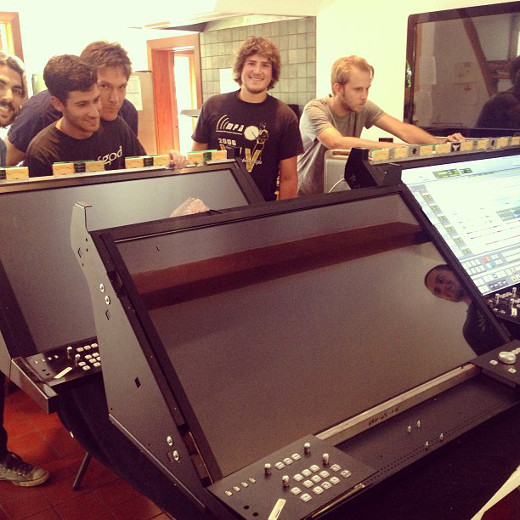
(l-r) Nicolas Aliberti, Nick Guadagnoli, Alex Oana, Matt Dodge, and Pete Beukelman, assembling pre-production prototypes at Slate HQ.
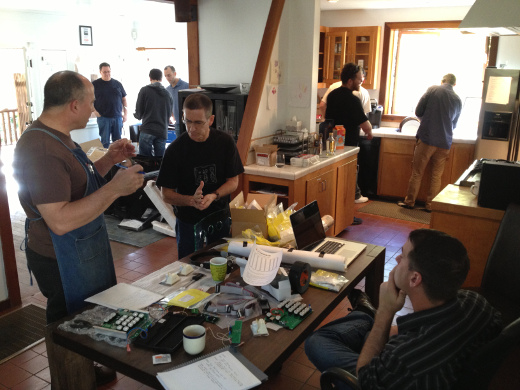
Inside the Slate workshop: (l-r) Mike Folgers, John Zigrang, Nick Guadagnoli, Tom Shochat, Dave Peck, Andrew Barnes, Leonard Bancroft, Matt Dorsey







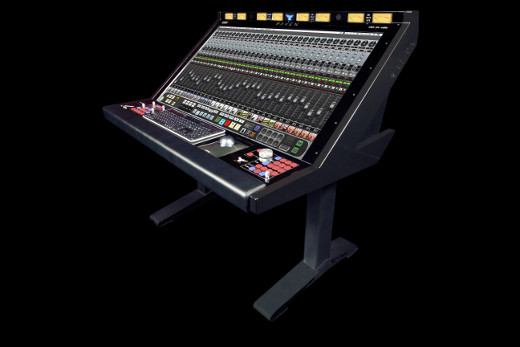
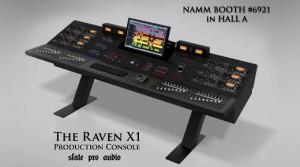
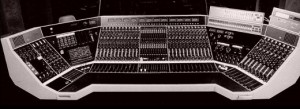
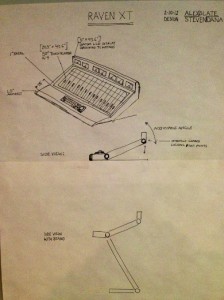
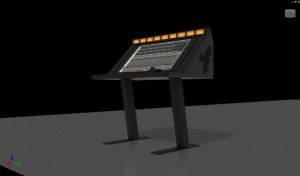
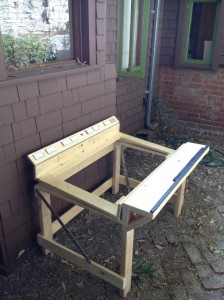
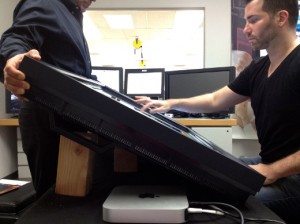
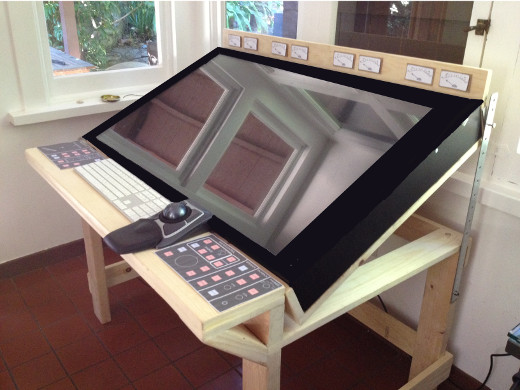
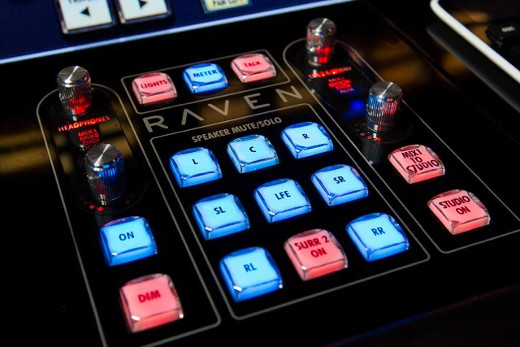
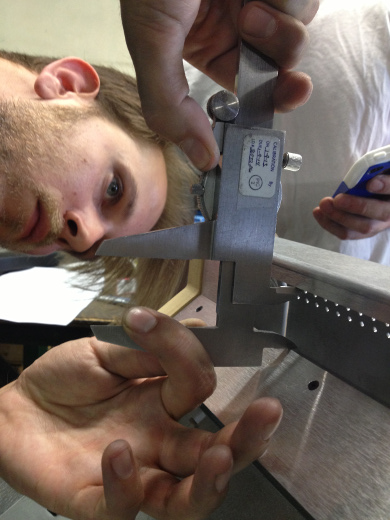
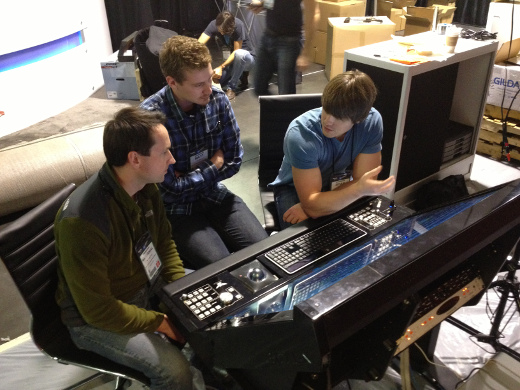
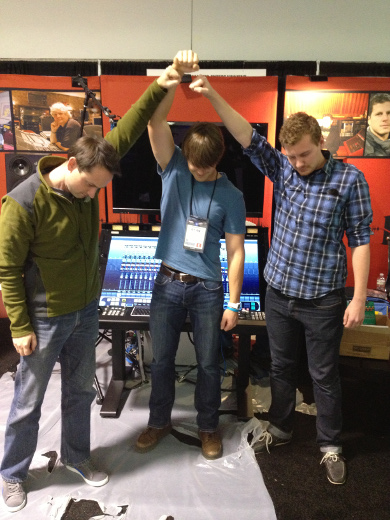
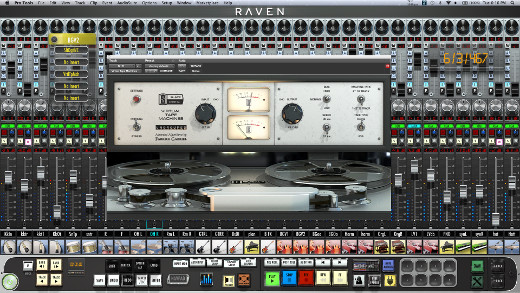
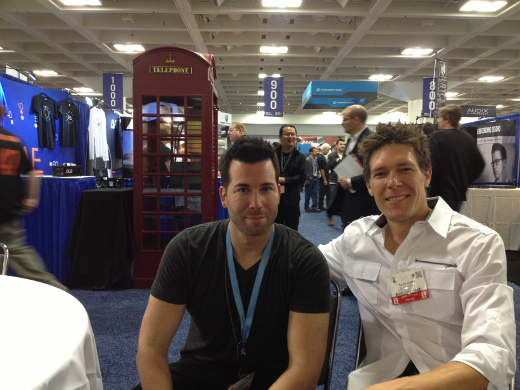
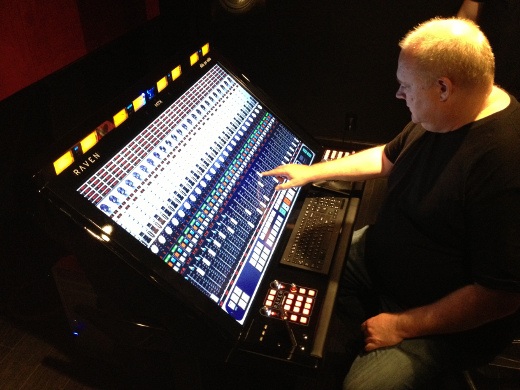
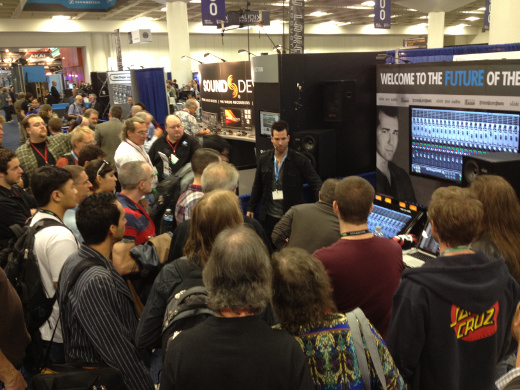
Bob M
July 11, 2013 at 2:24 pm (11 years ago)Wow, a digital console that makes manual and visual sense!
Aristedes Philip DuVal
July 11, 2013 at 2:48 pm (11 years ago)Exciting!!!!
4prongpitchfork
September 30, 2013 at 1:44 pm (11 years ago)I’d like to see/hear it in a real studio setting designed for it. Given the height, angle, sight line to monitors/window parameters/limitations, I’m sure a studio designer would have sonic considerations different from standard console installations. I’d be interested in seeing how a pro studio designer would approach/integrate a new equipment paradigm such as this.